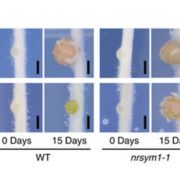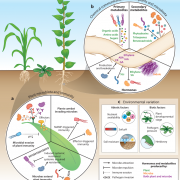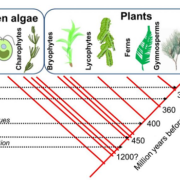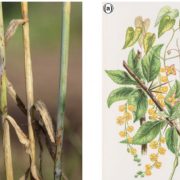Sequestration and activation of plant toxins protect the western corn rootworm from enemies at multiple trophic levels
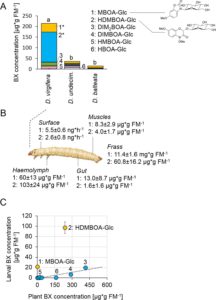 Plants are attacked by diverse herbivores but have also evolved strategies to resist them. However, highly adapted herbivores exist, including those that have evolved the ability to stabilize, sequester and reactivate plant toxins. This evolved trait has contributed to herbivore defense against higher trophic level enemies. A clear ecological significance of this interaction is shown in this recent work by Robert et al. in the western corn rootworm. The authors demonstrate that the western corn rootworm, an important maize pest, has an ability to accumulate the root-derived benzoxazinoid glucosides HDMBOA-Glc and MBOA-Glc. The herbivore stabilizes and sequesters the benzoxazinoid product MBOA making the insect highly resistant against attacking nematodes below-ground. Activation of the accumulated compound toxicity can be done by larvae, specifically by hydrolyzing HDMBOA-Glc to produce toxic MBOA. This is turn repels the infective juvenile nematodes. (Summary by Amey Redkar) eLife 10.7554/eLife.29307.001
Plants are attacked by diverse herbivores but have also evolved strategies to resist them. However, highly adapted herbivores exist, including those that have evolved the ability to stabilize, sequester and reactivate plant toxins. This evolved trait has contributed to herbivore defense against higher trophic level enemies. A clear ecological significance of this interaction is shown in this recent work by Robert et al. in the western corn rootworm. The authors demonstrate that the western corn rootworm, an important maize pest, has an ability to accumulate the root-derived benzoxazinoid glucosides HDMBOA-Glc and MBOA-Glc. The herbivore stabilizes and sequesters the benzoxazinoid product MBOA making the insect highly resistant against attacking nematodes below-ground. Activation of the accumulated compound toxicity can be done by larvae, specifically by hydrolyzing HDMBOA-Glc to produce toxic MBOA. This is turn repels the infective juvenile nematodes. (Summary by Amey Redkar) eLife 10.7554/eLife.29307.001



